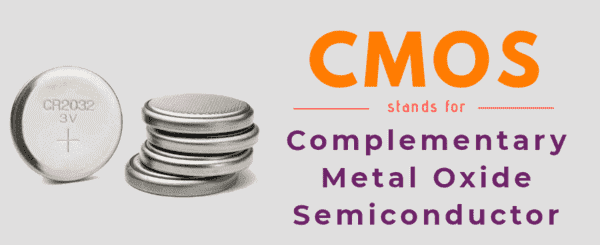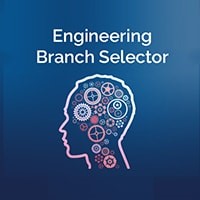CMOS full form is Complementary Metal-Oxide-Semiconductor, CMOS is a type of transistor technology that is used in the vast majority of modern integrated circuits, including microprocessors, memory chips, and other digital logic circuits. CMOS is preferred over other transistor technologies because it is very energy-efficient, produces very little heat, and is relatively easy to manufacture.
- CMOS full form: Introduction
- CMOS full form: Understanding CMOS Technology
- CMOS full form: How to use CMOS?
- CMOS full form: Inventor of CMOS
- CMOS full form: Roles of CMOS
- CMOS full form: History
- CMOS full form: Technical Details
- CMOS full form: Working Principles of CMOS
- CMOS full form: CMOS Fabrication Process
- CMOS full form: Advantages of CMOS Technology
- CMOS full form: Applications of CMOS
- CMOS full form: Challenges and Future Trends
- CMOS full form: Conclusion
- CMOS full form: FAQs
CMOS full form: Introduction

Imagine the world of electronics like a bustling city. In this city, you have tiny workers, so small you need a microscope to see them, running around and making important decisions. These tiny workers are known as transistors, and they play a fundamental role in making our gadgets work.
Complementary Metal-Oxide-Semiconductor, or CMOS for short, is like the ingenious blueprint that helps organize and manage these tiny workers efficiently. It’s the clever architecture that powers a significant chunk of our modern electronic devices, from smartphones to laptops and beyond.
In simpler terms, CMOS is a special way of organizing and using these microscopic workers (transistors) to create powerful, energy-efficient electronic circuits. Imagine it as the smart foreman who knows how to delegate tasks effectively, ensuring our gadgets run smoothly while sipping power cautiously.
CMOS full form: Understanding CMOS Technology
| Section | Description |
|---|---|
| 1. Introduction to CMOS | Brief overview of CMOS technology and its significance. |
| 2. CMOS Structure | Explaining the structure of CMOS and its components. |
| 3. Transistor Operation | Understanding how transistors work in a CMOS circuit. |
| 4. Complementary Operation | Explanation of how the complementary nature of CMOS is utilized. |
| 5. P-type and N-type Transistors | Differentiating between p-type and n-type transistors and their roles. |
| 6. Logic Gates in CMOS | How logic gates are implemented using CMOS technology. |
| 7. Power Consumption | Exploring the low power consumption aspect of CMOS. |
| 8. Signal Propagation | How signals propagate through CMOS circuits. |
CMOS full form: How to use CMOS?
| Category | Details |
|---|---|
| Full Form | Complementary Metal-Oxide-Semiconductor |
| Primary Use | Construction of integrated circuits (e.g., microprocessors, sensors, RAM) |
| Key Features | Low power consumption, high noise immunity, high density of logic functions |
| Applications | Microprocessors, digital cameras, image sensors, battery-powered devices |
| Advantages | Energy-efficient, generates less heat, can be scaled down for compact design |
| Technology Type | Semiconductor |
| Power Source | Operates at low voltage |
| Operation | Uses both p-type and n-type MOSFETs to create logic gates |
| Common Devices | Smartphones, computers, digital cameras, wearable devices |
CMOS full form: Inventor of CMOS
Frank Wanlass: Often identified because the most important inventor of CMOS generation. He evolved the basic CMOS design in 1963 whilst operating at Fairchild Semiconductor.
Willard S. Boyle: Contributed to the development of semiconductor technology, which performed a role within the development and refinement of CMOS generation.
George E. Smith: Worked alongside Boyle on improvements in semiconductor era, impacting the evolution of CMOS circuits.
Robert Noyce: Co-based Fairchild Semiconductor and later Intel; his paintings on integrated circuits inspired the improvement of CMOS technology.
Jack Kilby: Co-inventor of the included circuit, his contributions to semiconductor era laid the basis for CMOS improvement.
Gordon Moore: Co-founding father of Intel and acknowledged for Moore’s Law; his paintings in semiconductor improvements supported the growth and application of CMOS technology.
Andy Grove: As a key figure at Intel, he was concerned in the business and technological development of CMOS technology.
CMOS full form: Roles of CMOS
Digital Logic Circuits: CMOS is used to design good judgment gates (AND, OR, NOT, and so forth.), that are fundamental constructing blocks in digital circuits, consisting of processors and reminiscence units.
Microprocessors: CMOS technology is extensively used inside the layout of microprocessors and microcontrollers, enabling the development of powerful and power-efficient computing devices.
Memory Devices: CMOS is utilized in diverse varieties of memory, inclusive of SRAM (Static RAM) and DRAM (Dynamic RAM), offering high-velocity get right of entry to and occasional strength consumption.
Image Sensors: CMOS sensors are used in digital cameras, smartphones, and other imaging gadgets to capture light and convert it into electronic alerts.
Analog and Mixed-Signal Circuits: CMOS generation helps analog circuits and combined-signal applications, such as information converters (ADC/DAC), amplifiers, and oscillators.
Battery-Powered Devices: CMOS’s low strength intake makes it best to be used in battery-operated gadgets, extending battery lifestyles and enhancing strength efficiency.
Communication Devices: CMOS generation is used in numerous communique gadgets, such as wireless transceivers, routers, and modems, permitting green statistics transmission and reception.
Automotive Applications: CMOS sensors and circuits are utilized in cutting-edge motors for diverse features, including advanced driving force-help systems (ADAS), in-vehicle networking, and engine manage.
CMOS full form: History
| Year | Event |
|---|---|
| 1963 | Frank Wanlass invents CMOS technology while working at Fairchild Semiconductor. |
| 1968 | Fairchild Semiconductor commercializes the first CMOS integrated circuit. |
| 1971 | Intel introduces the first microprocessor using CMOS technology, the Intel 4004. |
| 1974 | IBM uses CMOS technology in the IBM System/370 Model 168, marking its adoption in mainframes. |
| 1980s | CMOS technology becomes widely adopted in personal computers and consumer electronics. |
| 1990s | Advancements in CMOS lead to the development of more complex and power-efficient devices. |
| 2000s | CMOS sensors become standard in digital cameras and smartphones. |
| 2010s | CMOS technology sees advancements in scaling and integration, supporting high-performance computing and low-power applications. |
CMOS full form: Technical Details
Design: CMOS technology uses two types of metal-oxide semiconductor field-effect transistors (MOSFETs) – n-type (NMOS) and p-type (PMOS) NMOS transistors are used to pull the output to ground, while PMOS transistors to the output the so supply voltage Draws.
Power consumption: CMOS circuits consume very little power at idle because no current flows through the transistor until it changes state. This is in contrast to other rational families that continue to dominate.
Voltage Level: CMOS devices operate over a voltage range, typically from 1.8V to 3.3V for modern applications. The voltage levels define the logic state: generally, a voltage near the supply voltage (Vdd) represents a logic high, while a voltage near ground (Vss) represents a logic low
Noise immunity: CMOS circuits have high noise immunity, which means they are less susceptible to electrical noise, contributing to reliable operation in a variety of environments
Scaling: CMOS technology enables transistors to shrink to smaller sizes, increasing performance and reducing power consumption. This scaling follows Moore’s law, which states that the number of transistors on a chip will double approximately every two years.
CMOS full form: Working Principles of CMOS
Complementary Metal-Oxide-Semiconductor (CMOS) technology is like a duo of efficient workers, each with a unique way of handling tasks. Imagine one worker (a transistor) loves to switch on the lights, and the other prefers turning them off. When they work together, they ensure the lights are managed flawlessly.
- The Duo: P-type and N-type Transistors
- P-type Transistors (The Light Switch-On Worker): These workers allow electrical current to flow when signaled, like turning on a light switch.
- N-type Transistors (The Light Switch-Off Worker): These workers block the flow of current when signaled, like turning off a light switch.
- Complementary Operation (The Light Management Team)
- Teamwork: By combining both types of workers (transistors), CMOS forms a powerful team. When one worker turns on the light, the other turns it off. This complementary action ensures efficient and precise management of electrical signals.
- Creating Logic (Switching the Lights On and Off)
- Logic Gates: Imagine logic gates as decision-making centers. By cleverly organizing these worker pairs, we create logic gates (like AND, OR, and NOT gates), enabling intricate decision-making processes in our devices.
- Saving Energy (Efficient Lighting)
- Low Power Consumption: The beauty of CMOS is that these workers consume very little energy, minimizing power usage and heat generation. It’s like having energy-efficient light bulbs that last a long time.
CMOS full form: CMOS Fabrication Process
| Step | Description |
|---|---|
| 1. | Preparing the Silicon Wafer (The Base): Start with a flat silicon wafer, which acts as the foundation for the electronic circuits. |
| 2. | Growing Insulating Layer (The First Layer): Create an insulating layer (e.g., silicon dioxide) on the wafer to provide insulation for the transistors. |
| 3. | Creating Transistor Areas (Designing the Workers’ Spaces): Use stencils and blueprints to mark and define areas where transistors will be placed. |
| 4. | Introducing P-type and N-type Materials (Hiring the Workers): Infuse specific areas with P-type and N-type materials to form the transistors, enabling different charge flow properties. |
| 5. | Building Transistors (Constructing the Workers): Assemble transistors by combining the P-type and N-type regions, forming the basic building blocks of CMOS circuits. |
| 6. | Connecting Transistors (Forming Networks): Create pathways to connect transistors and form logical circuits using conductive materials like metal. |
| 7. | Adding Contact and Metal Layers (Wiring the Circuit): Establish connections by adding metal layers for interconnection, allowing communication between different parts of the circuit. |
| 8. | Testing and Quality Assurance (Ensuring Functionality): Conduct extensive testing to ensure the fabricated CMOS circuit meets quality and functionality standards. |



















